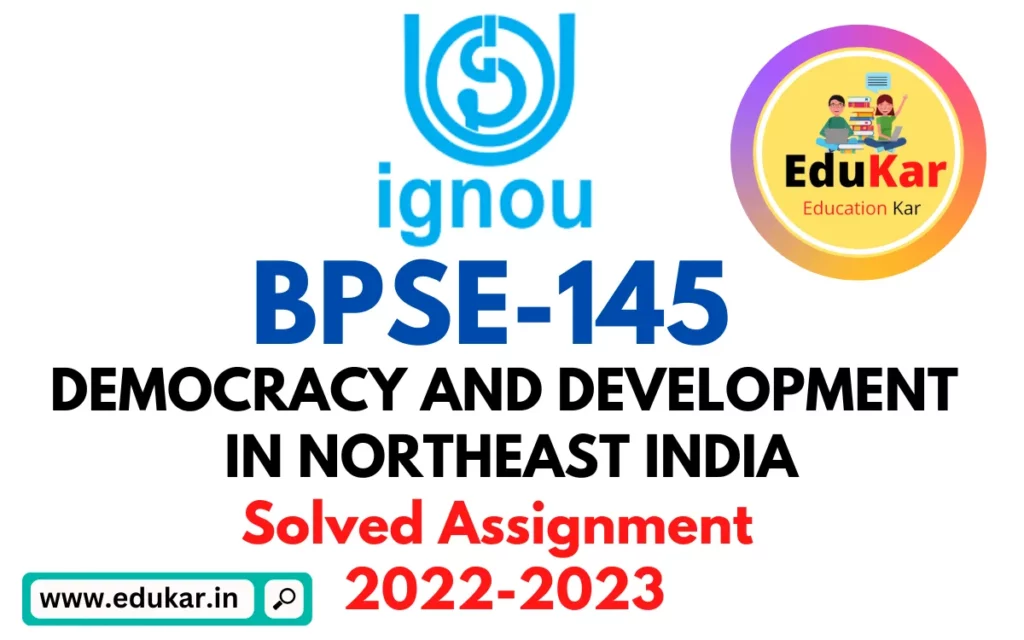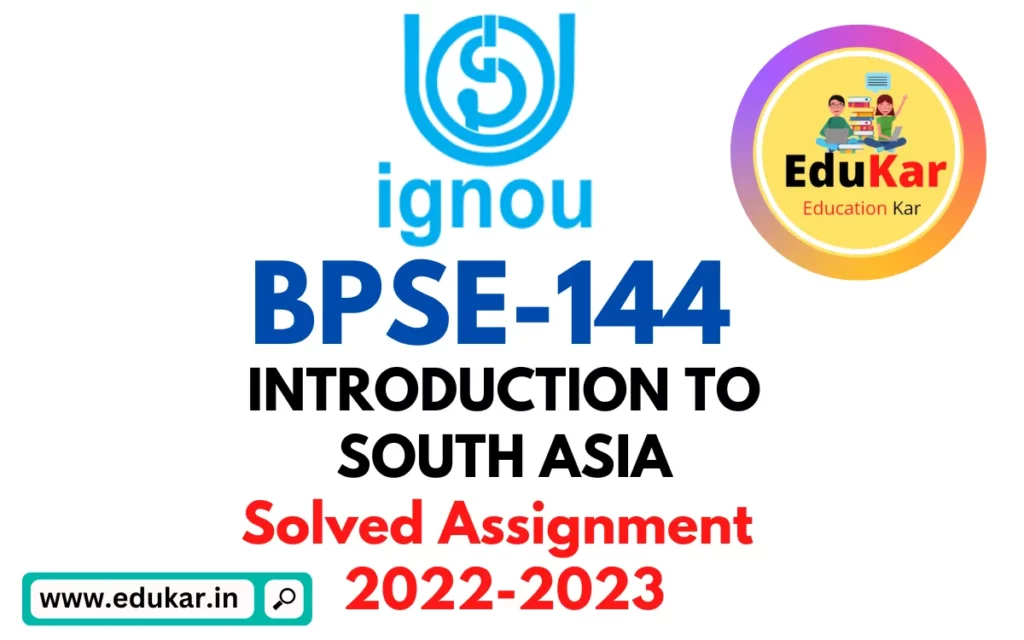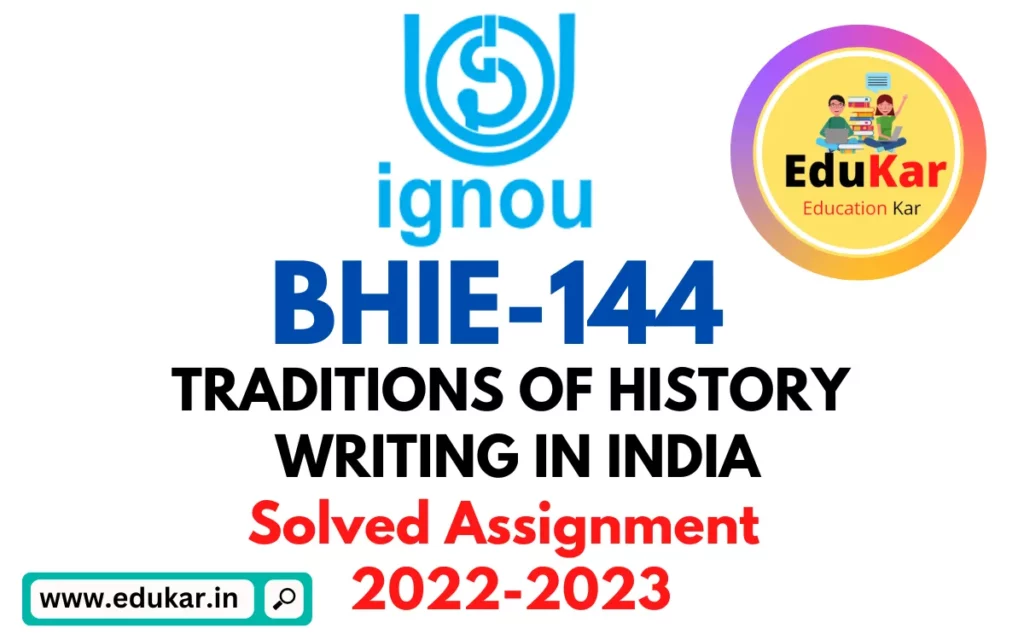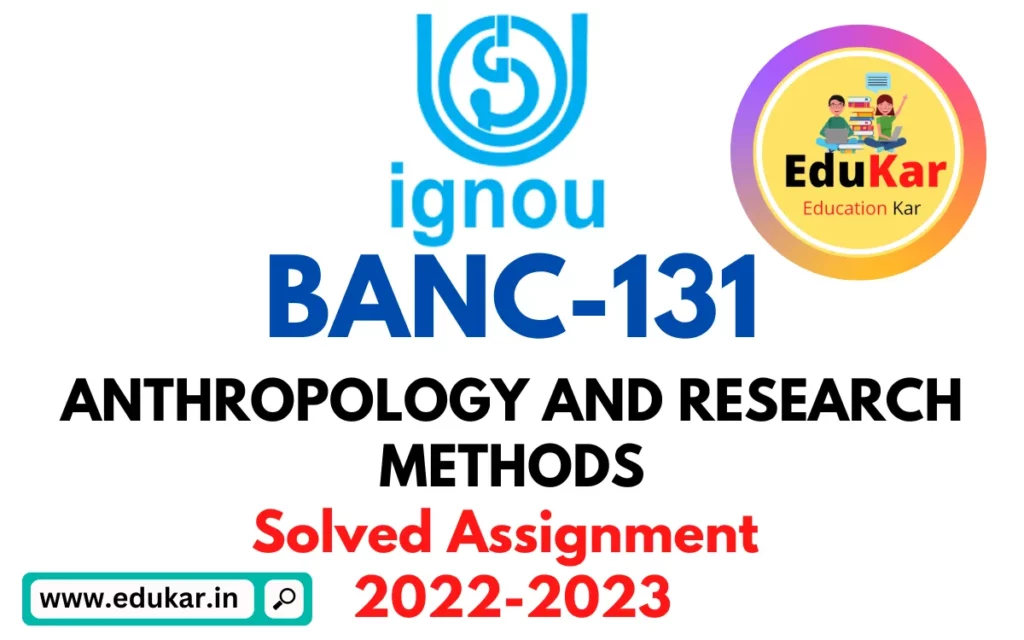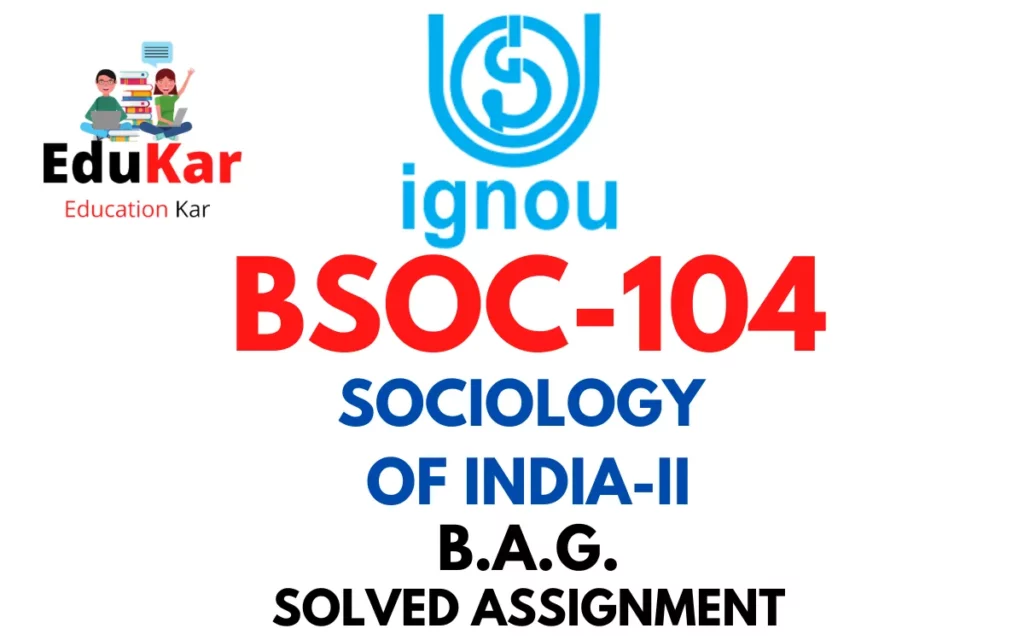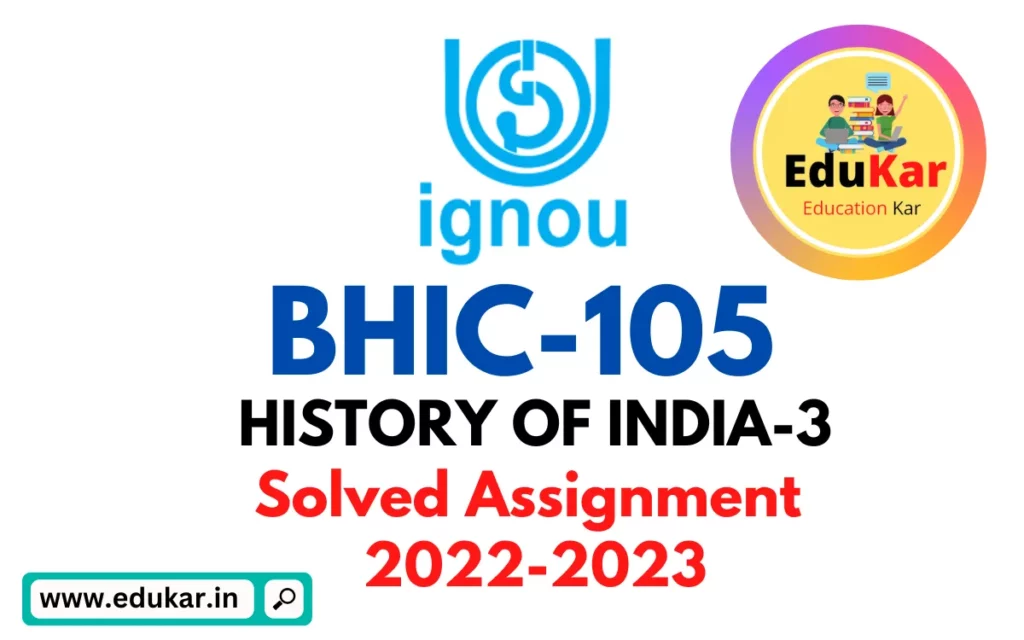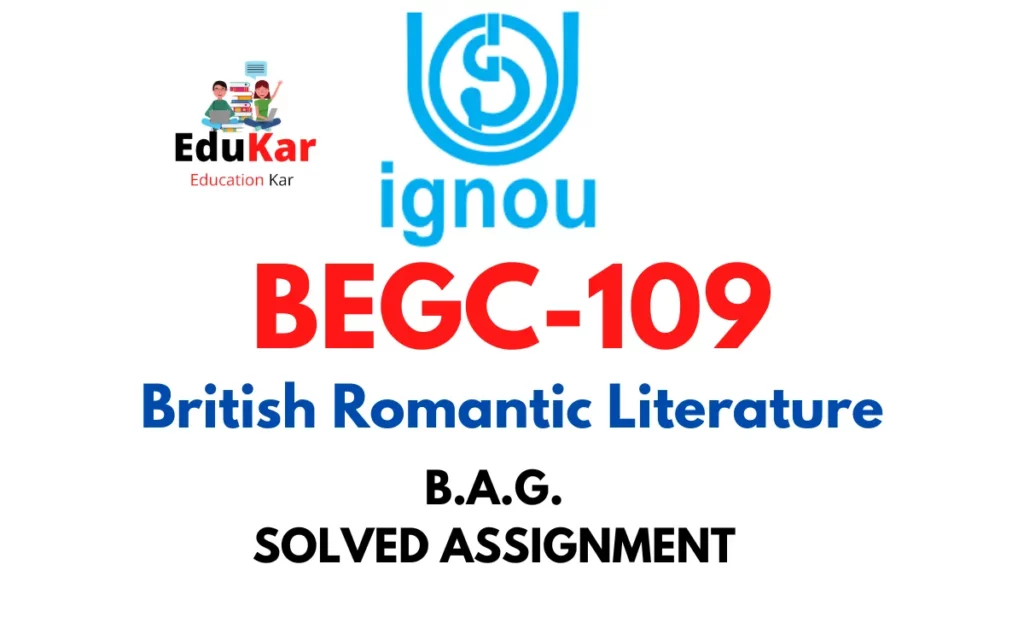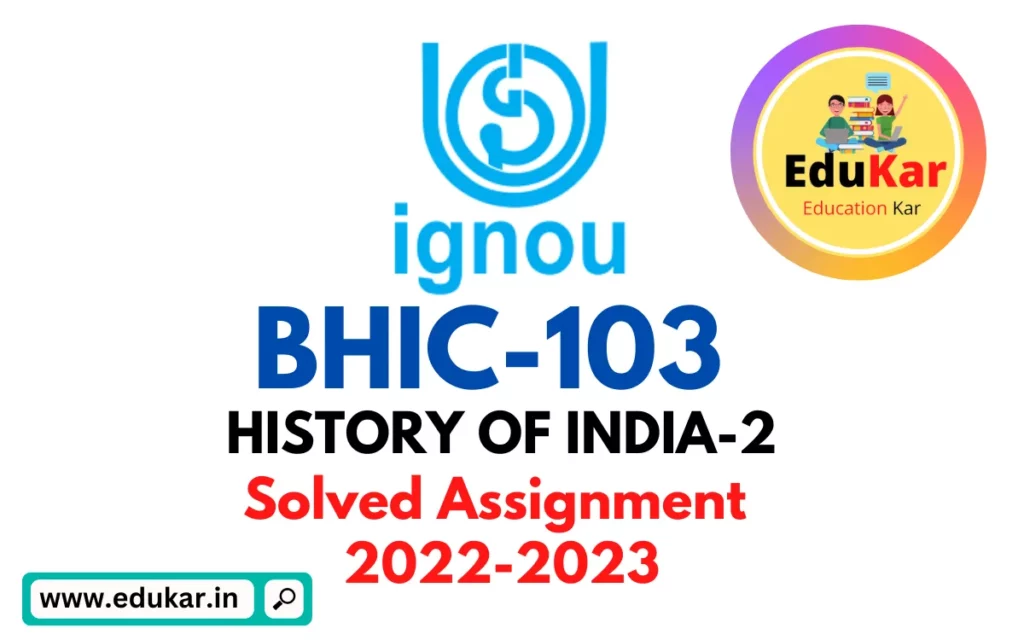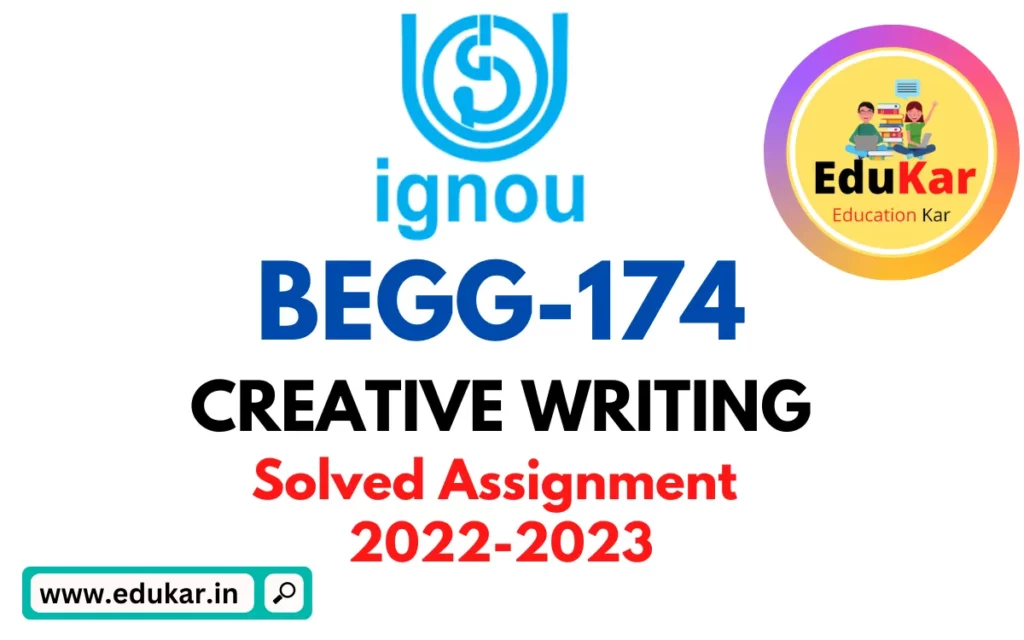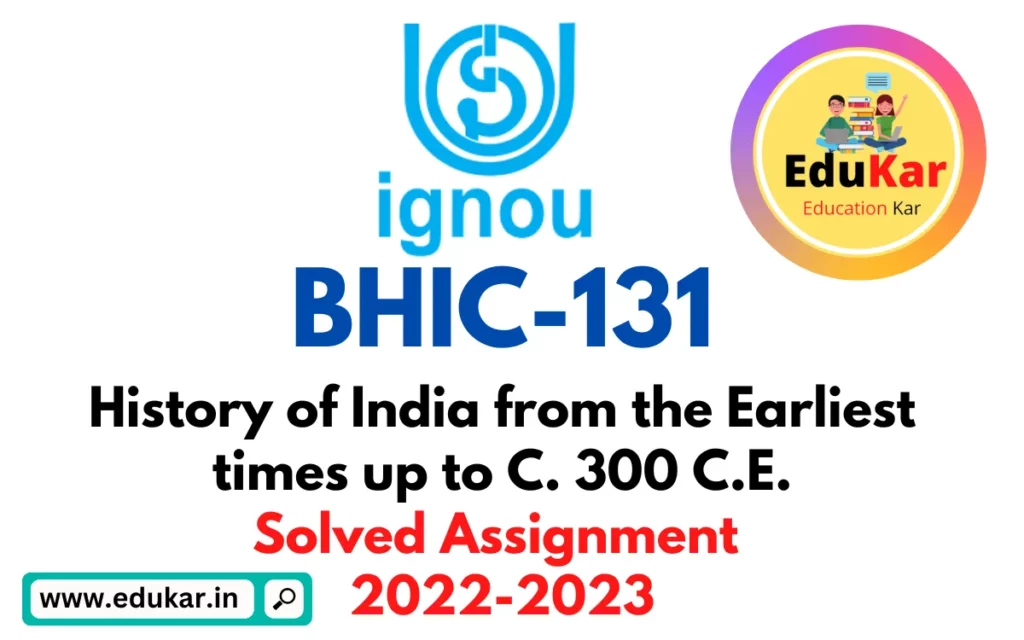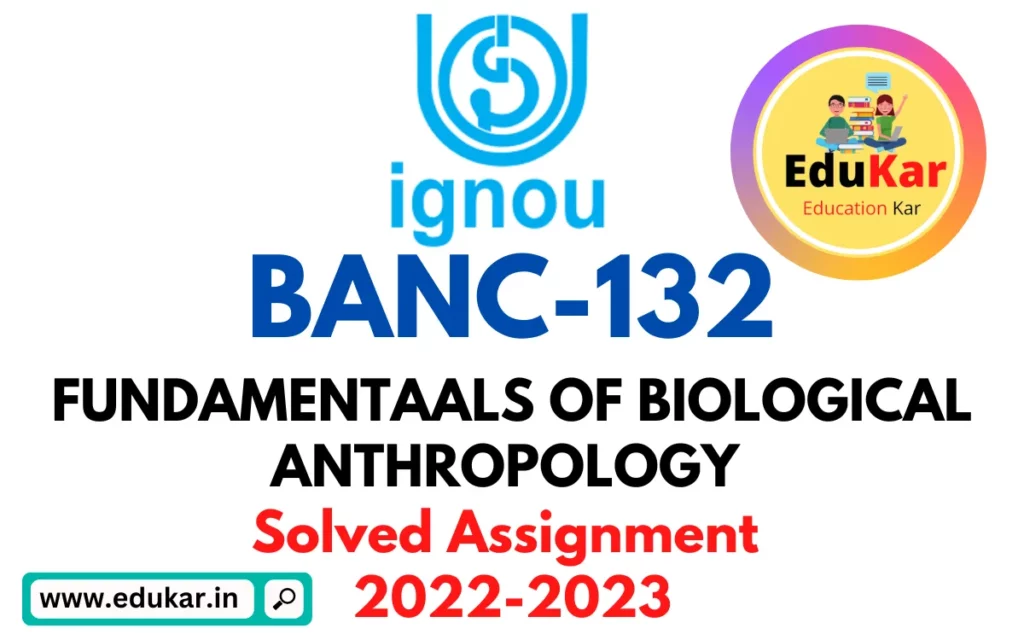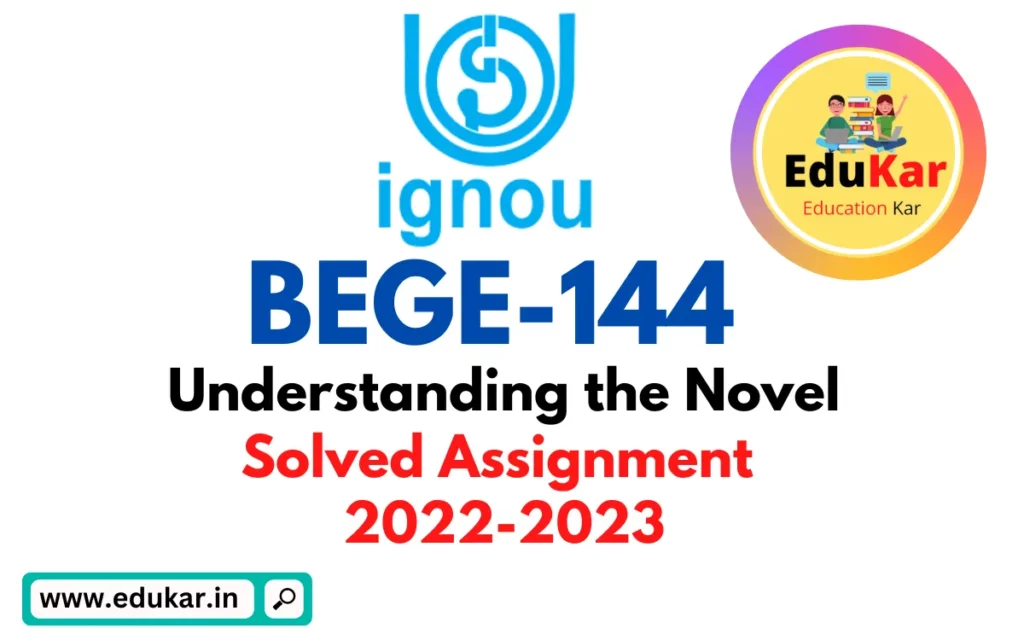Contents
- 1 Answer any five questions. All questions carry equal marks. (20 x 5 = 100)
- 2 1. What do you broadly understand by South African Literature? Is it different in any way from African Literature?
- 3 2. Who are some of the pioneers of postcolonial short story? Write about any two representative short stories.
- 4 3. Make a critical appraisal of the poetic devices used in the poem, “Tonight I can Write”.
- 5 4. Tendulkar has made use of song, dance, music, mime, dialogue and narration in the play Ghashiram Kotwal. Illustrate the extent to which these elements contribute to the total effect of the play.
- 6 5. Name and briefly describe the communities whose correspondences and transactions are found in South African writings.
- 7 6. Discuss poetry in the postcolonial space with critical notes on the poems from this course, BEGC-114.
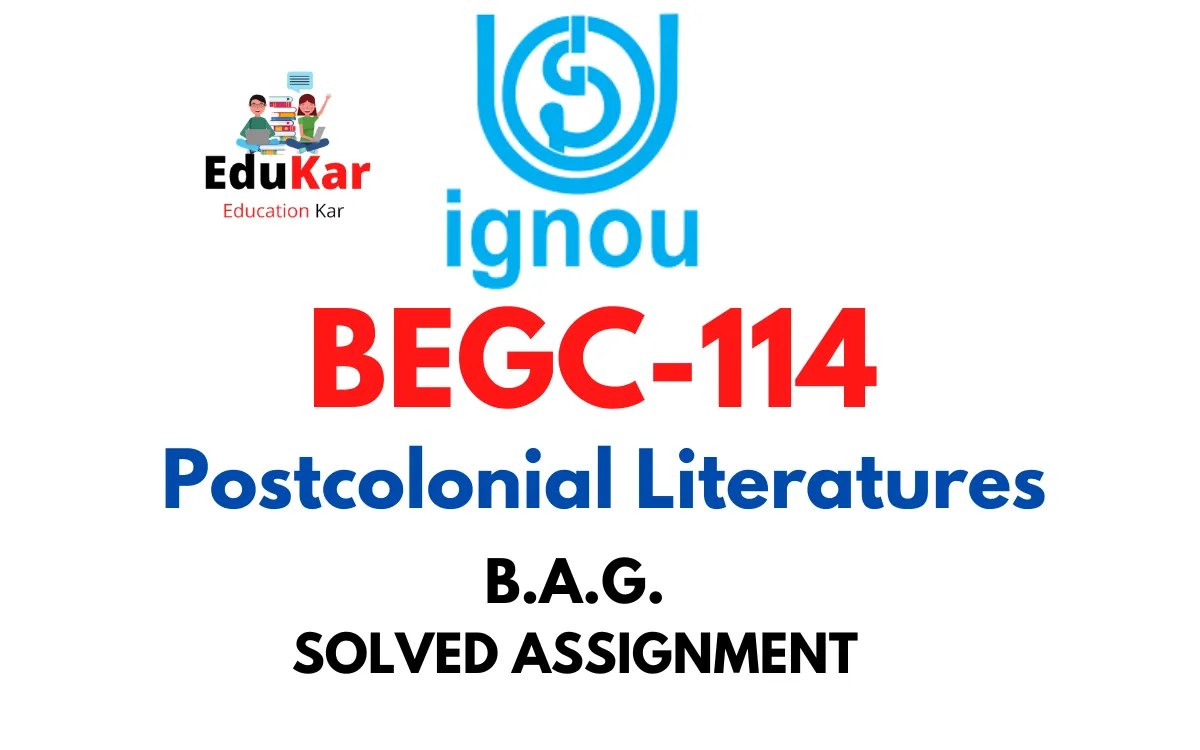
| Title | BEGC-114: IGNOU BAG Solved Assignment 2022-2023 |
| University | IGNOU |
| Degree | Bachelor Degree Programme |
| Course Code | BEGC-114 |
| Course Name | Postcolonial Literatures |
| Programme Name | Bachelor of Arts (General) |
| Programme Code | BAG |
| Total Marks | 100 |
| Year | 2022-2023 |
| Language | English |
| Last Date for Submission of Assignment: | For June Examination: 31st April For December Examination: 30th September |
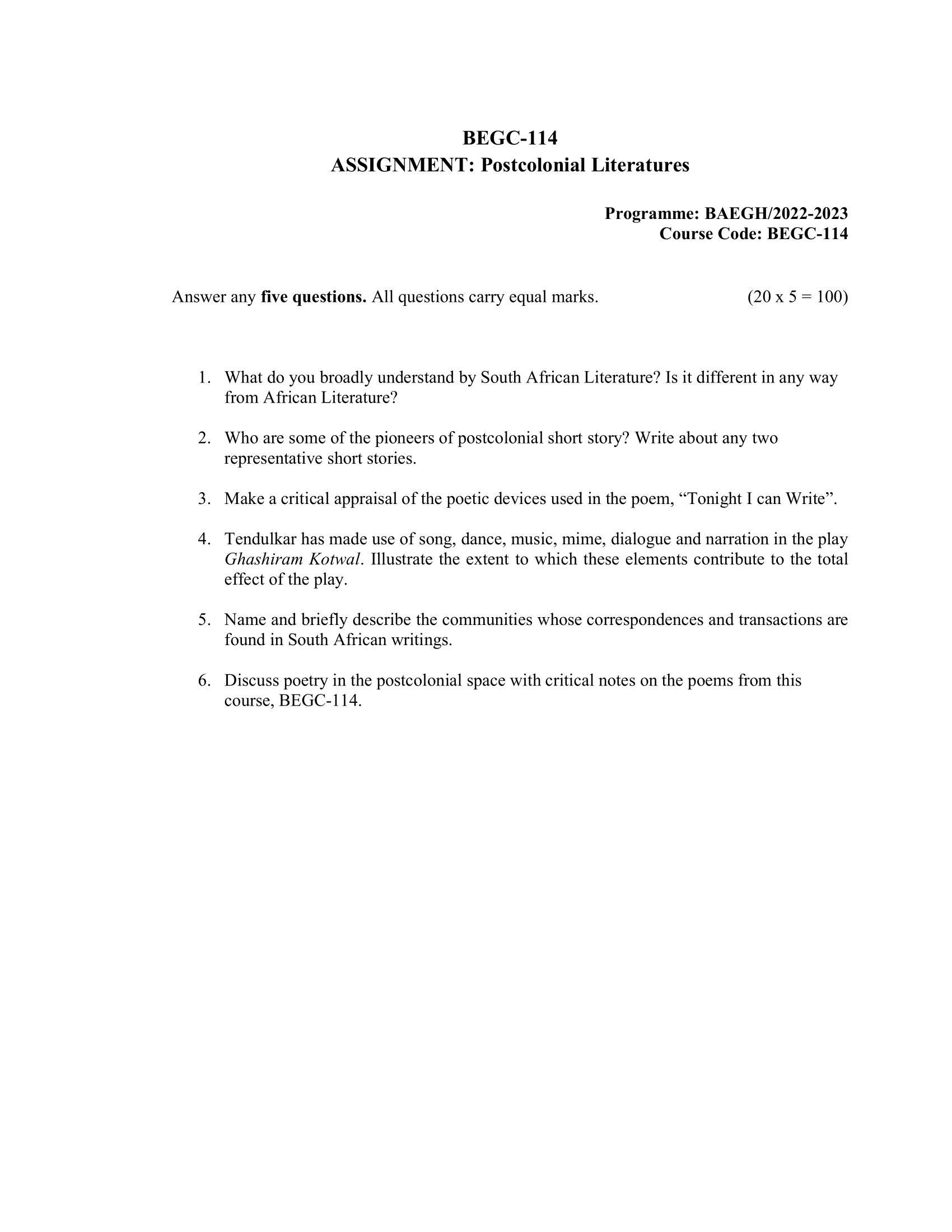
Answer any five questions. All questions carry equal marks. (20 x 5 = 100)
1. What do you broadly understand by South African Literature? Is it different in any way from African Literature?
Ans: South African literature is a rich and diverse field that has evolved over centuries, shaped by the unique history and cultural heritage of the region. It encompasses a wide range of genres, from fiction and poetry to drama and memoirs, and reflects the experiences of diverse communities, including indigenous populations, colonizers, and immigrants.
One of the most notable features of South African literature is its focus on issues of social justice and human rights. The country’s long history of apartheid and racial inequality has left an indelible mark on its literary traditions, with many writers using their work to critique the injustices and inequalities of the past and present. This focus on social issues is evident in the works of authors such as Nadine Gordimer, J.M. Coetzee, and Bessie Head, whose writing explores themes of political oppression, racial discrimination, and social inequality.
Another characteristic of South African literature is its multilingualism. The country is home to eleven official languages, and many writers draw on this linguistic diversity in their work. For example, Zakes Mda’s novel “Ways of Dying” incorporates elements of Zulu, Xhosa, and Afrikaans, while Es’kia Mphahlele’s “Down Second Avenue” uses a mixture of English, Zulu, and Sepedi to create a unique and vibrant literary voice.
In addition to its focus on social issues and multilingualism, South African literature is also notable for its engagement with African traditions and cultures. Many writers draw on indigenous storytelling techniques, incorporating elements such as oral narratives, myths, and proverbs into their work. This is evident in the poetry of Mongane Wally Serote, who often incorporates elements of African folklore into his writing, as well as the novels of Bessie Head, who draws on her own experiences growing up in a rural village in Botswana.
While South African literature shares many characteristics with African literature more broadly, it is also distinct in a number of ways. For one, South African literature reflects the particular historical, social, and political context of the region, which is shaped by the country’s colonial past, its struggles against apartheid, and its ongoing efforts to build a more just and equitable society. This context is reflected in the themes, styles, and perspectives of South African writers, who often engage with issues that are specific to the region.
Another way in which South African literature differs from African literature more broadly is its engagement with European literary traditions. South Africa has a long history of colonization and cultural exchange with Europe, and this is reflected in its literature. Many South African writers draw on European literary forms and techniques, such as the novel and the sonnet, to create works that blend African and European influences. This is evident in the poetry of Ingrid de Kok, who draws on both African and European traditions to create a unique and powerful literary voice.
Despite these differences, South African literature is part of a broader African literary tradition, one that is marked by its diversity, its engagement with social issues, and its commitment to telling the stories of a wide range of communities. Whether exploring the legacy of colonialism, the challenges of contemporary life, or the richness of African traditions and cultures, South African writers continue to make important contributions to this vibrant and dynamic literary tradition.
2. Who are some of the pioneers of postcolonial short story? Write about any two representative short stories.
Ans: The postcolonial short story is a genre that has emerged from the broader postcolonial literary movement, which seeks to explore the experiences of colonized and marginalized peoples and to challenge dominant Western narratives. Some of the pioneers of postcolonial short story include writers such as Chinua Achebe, Nadine Gordimer, and Salman Rushdie, who have helped to define the genre and to create a space for new voices and perspectives to emerge.
Two representative short stories from this genre are “The Stolen Party” by Liliana Heker and “The Grass is Singing” by Doris Lessing.
“The Stolen Party” is a story set in Argentina and follows a young girl named Rosaura, who is invited to a birthday party for the daughter of her mother’s employer. Rosaura is excited to attend the party, which she believes will be a grand and magical event. However, when she arrives, she realizes that she is only there to serve as a maid and that she will not be able to participate in the festivities. The story explores themes of social class and inequality, as well as the ways in which power and privilege can be used to exclude and marginalize those who are deemed “inferior.”
In “The Grass is Singing,” Lessing tells the story of Mary Turner, a white woman living on a farm in Rhodesia (now Zimbabwe) in the 1940s. Mary is unhappy in her marriage and feels trapped in her life on the farm. She hires a black servant named Moses, whom she treats poorly and with whom she becomes involved in a violent and destructive relationship. The story explores themes of race, gender, and power, and raises important questions about the legacy of colonialism and the ways in which it continues to shape the lives of people in postcolonial societies.
Both of these stories exemplify the hallmarks of the postcolonial short story, including a focus on the experiences of marginalized peoples, an engagement with issues of social justice and inequality, and a challenge to dominant Western narratives. They also demonstrate the ways in which the postcolonial short story can be used to explore complex and difficult themes, and to tell the stories of those who are often left out of mainstream literary discourse.
3. Make a critical appraisal of the poetic devices used in the poem, “Tonight I can Write”.
Ans: “Tonight I Can Write” is a poignant and emotionally charged poem by the Chilean poet Pablo Neruda. The poem explores themes of love, loss, and memory, and makes use of a range of poetic devices to create a powerful and evocative work of art. In this critical appraisal, I will analyze some of the key poetic devices used in the poem and consider their effects on the overall meaning and impact of the work.
One of the most striking aspects of the poem is its use of imagery. The poem is filled with vivid and evocative images that help to convey the speaker’s sense of loss and sadness. For example, in the opening lines of the poem, the speaker describes the night sky as “starry and shivering.” This image conveys a sense of coldness and loneliness, which echoes the speaker’s own feelings of isolation and sorrow. Throughout the poem, Neruda uses a range of images, from the “yellow hazel leaves” of autumn to the “infinite distance” of the sea, to create a rich and layered portrait of the speaker’s emotional landscape.
Another important poetic device used in the poem is repetition. Neruda repeats certain words and phrases throughout the poem, creating a sense of rhythm and intensity that helps to reinforce the central themes of the work. For example, the phrase “tonight I can write” is repeated throughout the poem, becoming a kind of refrain that echoes the speaker’s own sense of urgency and need to express his emotions. Similarly, the word “love” appears repeatedly in the poem, underscoring the speaker’s deep and abiding attachment to the person he has lost.
Neruda also makes use of metaphor and symbolism in the poem, using these devices to create layers of meaning and significance. For example, the image of the night sky is used as a metaphor for the speaker’s own emotional state, with the stars representing his memories and the darkness representing his sense of loss. Similarly, the use of the color green throughout the poem can be seen as a symbol of the speaker’s hope and longing, as well as a reminder of the beauty of the natural world that he still carries with him.
Finally, the poem makes use of a range of sound devices, including rhyme, alliteration, and assonance, to create a musical and lyrical quality that adds to its emotional impact. For example, the repetition of the “s” sound in the phrase “starry and shivering” creates a sense of coldness and isolation, while the use of internal rhyme in the line “my heart looks for her, and she is not with me” helps to create a sense of longing and regret.
4. Tendulkar has made use of song, dance, music, mime, dialogue and narration in the play Ghashiram Kotwal. Illustrate the extent to which these elements contribute to the total effect of the play.
Ans: Vijay Tendulkar’s play “Ghashiram Kotwal” is a landmark of modern Indian theatre, known for its innovative use of various theatrical elements. Tendulkar’s play incorporates song, dance, music, mime, dialogue, and narration to create a complex and multilayered theatrical experience. Here are some examples of how each of these elements contributes to the total effect of the play:
- Song: Tendulkar’s use of song in “Ghashiram Kotwal” serves several purposes. First, it helps to establish the cultural and historical context of the play, as the songs are drawn from traditional Marathi theatre and folk music. Second, the songs provide a contrast to the more realistic and naturalistic scenes of the play, creating a heightened sense of theatricality and stylization. Finally, the songs often serve a satirical or ironic function, commenting on the action of the play and critiquing the social and political realities of the time.
- Dance: The use of dance in “Ghashiram Kotwal” is closely connected to the songs, as the dancers often perform in conjunction with the musical numbers. Like the songs, the dance sequences contribute to the play’s overall stylization and theatricality, while also serving a satirical or ironic function. The use of dance also helps to create a sense of spectacle and excitement, drawing the audience into the world of the play.
- Music: Music plays a key role in setting the mood and tone of “Ghashiram Kotwal”. The play makes use of a variety of musical styles, from traditional Marathi music to more modern and experimental forms. The music also helps to underscore the emotions of the characters, heightening the tension and drama of the play.
- Mime: Tendulkar’s use of mime in “Ghashiram Kotwal” is particularly effective in conveying the violence and brutality of the play’s central conflict. The use of stylized movements and gestures creates a sense of abstraction and distance, while also intensifying the impact of the play’s more violent and disturbing moments.
- Dialogue: The dialogue in “Ghashiram Kotwal” is notable for its sharpness and wit, as well as its ability to convey complex social and political issues. The characters often engage in rapid-fire exchanges that reveal their personalities and motivations, while also highlighting the social and economic inequalities of the time.
- Narration: Finally, Tendulkar’s use of narration in “Ghashiram Kotwal” serves to provide a larger context for the action of the play. The narrator often comments on the historical and social background of the story, drawing attention to the broader forces at work in the play’s world. This helps to create a sense of depth and complexity, as well as underscoring the play’s satirical and critical perspective.
5. Name and briefly describe the communities whose correspondences and transactions are found in South African writings.
Ans: South African writings reflect the correspondences and transactions of a range of communities that have shaped the country’s complex social, cultural, and political landscape. Here are some examples of the communities whose experiences and perspectives are reflected in South African literature:
- Black South Africans: Black South Africans make up the majority of the country’s population and have been historically marginalized by the apartheid regime. South African literature written by black authors often reflects the experiences of oppression, resistance, and liberation, as well as the rich cultural traditions of diverse ethnic groups such as the Zulu, Xhosa, Sotho, and Tswana.
- Coloured South Africans: Coloured South Africans are a mixed-race population that developed during the colonial and apartheid periods. They have a distinct cultural and linguistic identity, with influences from African, Asian, and European traditions. South African literature by coloured authors often reflects the complexities of identity, as well as the challenges and possibilities of living in a diverse and dynamic society.
- White South Africans: White South Africans are a minority population that historically held power and privilege under the apartheid regime. However, some white South Africans have also been critical of apartheid and have worked to promote social justice and reconciliation. South African literature by white authors often reflects the complexities of racial identity, as well as the challenges of living in a country undergoing rapid social and political change.
- Indian South Africans: Indian South Africans are a minority population with a distinct cultural and linguistic identity, shaped by the country’s history of colonialism and indentured labor. South African literature by Indian authors often reflects the experiences of migration, cultural hybridity, and the struggle for recognition and equality.
- LGBTQ+ South Africans: South Africa has one of the most progressive constitutions in the world when it comes to LGBTQ+ rights. South African literature by LGBTQ+ authors often reflects the experiences of discrimination, stigma, and violence, as well as the joys and complexities of queer life in a changing society.
These communities are just a few examples of the diverse range of experiences and perspectives reflected in South African literature. Through their powerful narratives and imaginative visions, South African writers have contributed to a rich and complex body of literature that speaks to the challenges and possibilities of living in a diverse and dynamic society.
6. Discuss poetry in the postcolonial space with critical notes on the poems from this course, BEGC-114.
Ans: Poetry in the postcolonial space is a complex and multi-faceted phenomenon. The poetry from the course BEGC-114 reflects the varied experiences and perspectives of poets from postcolonial societies, grappling with the legacy of colonialism and seeking to articulate their own identities and histories.
One of the key themes that emerges in this poetry is the search for a cultural identity that is distinct from the colonizer’s culture. This is evident in the poems of Derek Walcott, a Caribbean poet who won the Nobel Prize for Literature in 1992. Walcott’s poem “A Far Cry from Africa” grapples with the complexities of his mixed racial heritage and the legacy of colonialism in his native land. The poem begins with a vivid depiction of the violence and bloodshed of the Mau Mau rebellion in Kenya, before turning to Walcott’s own experience of being caught between his African and European heritage. Ultimately, the poem suggests that the quest for a cultural identity that is not bound up with the legacy of colonialism is a difficult and painful one, marked by ambivalence and contradiction.
Another important theme in postcolonial poetry is the struggle for political liberation and social justice. This is evident in the poems of Mahmoud Darwish, a Palestinian poet who was a leading voice in the struggle for Palestinian independence. Darwish’s poem “Identity Card” is a powerful statement of the Palestinian people’s determination to resist oppression and reclaim their homeland. The poem’s repeated refrain, “Write it down! I am an Arab,” emphasizes the speaker’s refusal to be defined by the colonizer’s categories or to accept a subordinate status. The poem celebrates the resilience and vitality of Palestinian culture, even in the face of occupation and displacement.
In addition to these broader themes, postcolonial poetry is marked by a rich and diverse array of literary techniques and forms. Many postcolonial poets draw on their own cultural traditions, weaving together multiple languages, dialects, and oral traditions to create a vibrant and polyphonic poetry. This is evident in the work of Kamau Brathwaite, a Caribbean poet who has been influential in the development of a distinctively Caribbean poetics. Brathwaite’s poem “Caliban” reimagines the character from Shakespeare’s The Tempest as a symbol of the oppressed and colonized peoples of the Caribbean. The poem is a collage of different languages and dialects, incorporating elements of African, European, and Caribbean culture into a powerful and resonant expression of resistance and self-determination.
Overall, the poetry of the postcolonial space is characterized by a profound engagement with the legacies of colonialism and the ongoing struggles for cultural identity, political liberation, and social justice. The poets from BEGC-114 are just a few examples of the rich and varied tradition of postcolonial poetry, which continues to thrive and evolve in response to the changing realities of the contemporary world. Through their innovative use of language, form, and content, these poets have contributed to a vibrant and polyphonic body of literature that speaks to the complex and multifaceted nature of the postcolonial experience.
How to Download BEGC-114 Solved Assignment?
You can download it from the www.edukar.in, they have a big database for all the IGNOU solved assignments.
Is the BEGC-114 Solved Assignment Free?
Yes this is absolutely free to download the solved assignment from www.edukar.in
What is the last submission date for BEGC-114 Solved Assignment?
For June Examination: 31st April, For December Examination: 30th October

